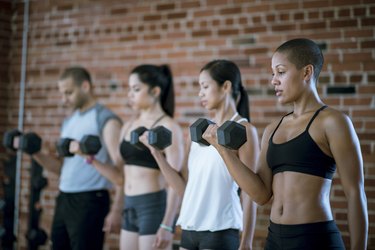
Biceps training is an important part of any bodybuilding program, and it is essential if you want defined, sculpted arm muscles. However, after a biceps workout, you may occasionally feel soreness in the tendons attached to this muscle.
If this occurs, it's important that you know why it happens, how you can treat it, and the measures you may take to avoid having it happen again.
Video of the Day
Video of the Day
Biceps Muscle Anatomy
Your biceps muscle crosses both the elbow and the shoulder joints. At the elbow, it performs flexion, or bending, and supination, or rotating your forearm into a palm-up position.
One head of the biceps muscle also helps with shoulder flexion, or lifting your arm up in front of you. During a typical biceps workout, exercises are focused at the elbow rather than the shoulder.
Elbow Soreness After Bicep Curls
Elbow soreness after bicep curls is likely caused by either biceps tendinitis or medial epicondylitis; the latter condition is more commonly known as golfer's elbow.
If it's biceps tendinitis, soreness is most often at the front of the elbow. If it's golfer's elbow, then you're more likely to have inner elbow pain after bicep curls.
Both of these conditions involve pain, stiffness and inflammation, which worsen during and after workouts.
Causes of Elbow Pain
Biceps tendinitis and golfer's elbow are both overuse injuries and caused by doing repetitive, strenuous movements regularly over a period of time.
At the shoulder, biceps tendinitis is usually brought on by doing too many overhead exercises. At the elbow, it is most often caused by repeated flexion, or bending. Golfer's elbow is caused by excessive wrist and finger flexion, which happens when you perform any curling movements.
Read more: Stretches for Shoulder Tendonitis
Treatment for Tendinitis
The first step in treating tendinitis is to cease performing any activities that cause the onset of soreness or pain, and rest the area for about three weeks.
Before you start training again, try some light stretching on joint movements to check that there is no pain; then begin training, using light weights and not taking any exercises to the point of failure or poor form.
If the pain continues, see a doctor or physiotherapist, who can refer you for further treatments such as active release technique or sports massage.
Prevention of Elbow Pain
Once the soreness has completely subsided and you have started training again, remaining injury free is vital. To prevent the muscles and tendons from becoming tight, regularly stretch after every workout and don't use weights that are too heavy.
Keep your wrist straight while performing bicep curls to reduce tension on your wrist muscle tendons. Using weights that are too heavy can lead to bad form. One indicator that your weight is too heavy is arching your back as you bend your elbow or leaning forward as you lower it back down.
If any exercise causes the pain to start again, immediately cease performing it and find an alternative exercise. Regular sports massage may also help to keep your tendons free of injury.
Read more: Elbow Tendonitis Stretches